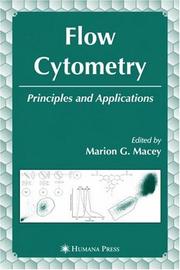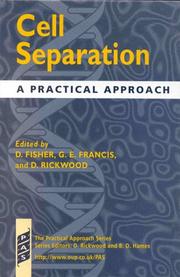| Listing 1 - 10 of 45 | << page >> |
Sort by
|
Book
ISBN: 9780128222102 Year: 2024 Publisher: San Diego : Elsevier Science & Technology,
Abstract | Keywords | Export | Availability | Bookmark
 Loading...
Loading...Choose an application
- Reference Manager
- EndNote
- RefWorks (Direct export to RefWorks)
This book explores the innovative field of single-cell multiplex proteomic technologies, providing a comprehensive overview of current platforms and methodologies in studying cellular biology at an unprecedented level. Edited by Wendy J. Fantl, it gathers insights from leading researchers and covers topics like mass cytometry, imaging mass cytometry, and multiplexed ion beam imaging, among others. The book aims to advance understanding in the spatial biology of tissues and highlights the potential applications in medical research, particularly in cancer and immunology. It is intended for researchers, practitioners, and students in the fields of biology, medicine, and biotechnology, offering both foundational principles and future directions in the field.
Proteomics. --- Cytometry. --- Proteomics --- Cytometry
Book
ISBN: 1773617702 9781773617701 9781773613888 Year: 2019 Publisher: Oakville, ON : Delve Publishing,
Abstract | Keywords | Export | Availability | Bookmark
 Loading...
Loading...Choose an application
- Reference Manager
- EndNote
- RefWorks (Direct export to RefWorks)
Flow cytometry allows a cell population to be analysed. This book describes the technology involved. This book covers managing flow cytometry/cell sorting core facilities for the emerging researchers, in particular in developmental, cellular, and molecular biology. This is a most useful book which will be a welcome addition for personal use and also for laboratories in a variety of disciplines.
Book
Year: 2020 Publisher: Frontiers Media SA
Abstract | Keywords | Export | Availability | Bookmark
 Loading...
Loading...Choose an application
- Reference Manager
- EndNote
- RefWorks (Direct export to RefWorks)
This eBook is a collection of articles from a Frontiers Research Topic. Frontiers Research Topics are very popular trademarks of the Frontiers Journals Series: they are collections of at least ten articles, all centered on a particular subject. With their unique mix of varied contributions from Original Research to Review Articles, Frontiers Research Topics unify the most influential researchers, the latest key findings and historical advances in a hot research area! Find out more on how to host your own Frontiers Research Topic or contribute to one as an author by contacting the Frontiers Editorial Office: frontiersin.org/about/contact
flow cytometry --- primary immunodeficency --- immunophenotyping --- diagnosis --- functional studies
Book
ISBN: 9535125516 9535154451 9535125508 Year: 2016 Publisher: IntechOpen
Abstract | Keywords | Export | Availability | Bookmark
 Loading...
Loading...Choose an application
- Reference Manager
- EndNote
- RefWorks (Direct export to RefWorks)
Flow cytometry - Select Topics is a collection of chapters that illustrate the constantly evolving application of flow cytometry to diverse areas of research or clinical investigations. It includes chapters on the utilization of flow cytometry in the fields of human reproduction and fertility, platelet function, apoptosis, inflammation research, leukemia immunophenotyping, and transplantation.
Flow cytometry. --- Cell counting, Laser --- Cell separation, Laser --- Cell sorting, Laser --- Flow cytofluorometry --- Flow cytophotometry --- Laser cell counting --- Laser cell separation --- Laser cell sorting --- Cytometry --- Medical genetics
Book
ISBN: 1628087102 9781628087109 9781628087093 1628087099 Year: 2013 Publisher: New York : Nova Biomedical,
Abstract | Keywords | Export | Availability | Bookmark
 Loading...
Loading...Choose an application
- Reference Manager
- EndNote
- RefWorks (Direct export to RefWorks)
Flow cytometry is a method to conduct a multiparameter analysis of cells suspended in liquid and passing through a laser beam. As cells pass through the flow chamber they are hit with the laser light beam which is scattered in different directions and recorded as forward light scatter and side light scatter. In this book, the authors discuss the principles, methodology and applications of flow cytometry. Topics include flow cytometry and epifluorescence analyses of freshwater bacterio- and virioplankton communities; application of flow cytometry in phenotyping, analysis and functional characte
Flow cytometry. --- Cell counting, Laser --- Cell separation, Laser --- Cell sorting, Laser --- Flow cytofluorometry --- Flow cytophotometry --- Laser cell counting --- Laser cell separation --- Laser cell sorting --- Cytometry
Book
ISBN: 1536146447 9781536146448 1536146439 9781536146431 Year: 2019 Publisher: New York : Nova Medicine & Health,
Abstract | Keywords | Export | Availability | Bookmark
 Loading...
Loading...Choose an application
- Reference Manager
- EndNote
- RefWorks (Direct export to RefWorks)
Flow cytometry. --- Cell counting, Laser --- Cell separation, Laser --- Cell sorting, Laser --- Flow cytofluorometry --- Flow cytophotometry --- Laser cell counting --- Laser cell separation --- Laser cell sorting --- Cytometry
Book
ISBN: 9783031108365 Year: 2022 Publisher: Cham Springer International Publishing :Imprint: Springer
Abstract | Keywords | Export | Availability | Bookmark
 Loading...
Loading...Choose an application
- Reference Manager
- EndNote
- RefWorks (Direct export to RefWorks)
Flow cytometry. --- Cell counting, Laser --- Cell separation, Laser --- Cell sorting, Laser --- Flow cytofluorometry --- Flow cytophotometry --- Laser cell counting --- Laser cell separation --- Laser cell sorting --- Cytometry --- Citometria de fluxe

ISBN: 1280972165 9786610972166 1597454516 1588296911 Year: 2007 Publisher: Totowa, N.J. : Paisley : Humana ; Quantum [distributor],
Abstract | Keywords | Export | Availability | Bookmark
 Loading...
Loading...Choose an application
- Reference Manager
- EndNote
- RefWorks (Direct export to RefWorks)
Flow cytometry forms an integral part of both basic biological research and clinical diagnosis in pathology. This straightforward new volume provides a clear, easy-to-read, and practical manual for both clinicians and non-clinicians at all levels of their careers. The chapter topics range from basic principles to more advanced subjects, such as apoptosis and cell sorting. Throughout Flow Cytometry: Principles and Applications, well-informed expert contributors present theoretical descriptions and practical protocols on this important and complex laboratory technique and its applications. Immunologists and Hematologists in the field of pathology, as well as biological researchers working with both human and animal models will appreciate the simple, clear-cut style in which principles and protocols in this volume are presented, and will refer to this book time and time again for clear and easy-to-follow protocols.
Flow cytometry. --- Cell separation. --- Cell isolation --- Cell segregation --- Cells --- Cytometry --- Separation (Technology) --- Cell counting, Laser --- Cell separation, Laser --- Cell sorting, Laser --- Flow cytofluorometry --- Flow cytophotometry --- Laser cell counting --- Laser cell separation --- Laser cell sorting --- Separation --- Cell separation --- Cytodiagnosis --- Flow cytometry --- Cell Separation --- Flow Cytometry --- Cytologic diagnosis --- Diagnosis, Cytologic --- Diagnostic cytopathology --- Diagnosis, Laboratory --- Pathology, Cellular --- methods

ISBN: 1280375396 9786610375394 0585483477 9780585483474 9781280375392 9780191565557 0191565555 138304905X 0199635803 019963579X Year: 2023 Publisher: Oxford : Oxford University Press,
Abstract | Keywords | Export | Availability | Bookmark
 Loading...
Loading...Choose an application
- Reference Manager
- EndNote
- RefWorks (Direct export to RefWorks)
Techniques for separating cells are needed in many areas of cell biology. This text presents modern methods from the laboratories of experts in the field and includes tested, reproducible protocols, hints and tips and troubleshooting techniques.
Cell separation. --- Cell isolation --- Cell segregation --- Cells --- Cytometry --- Separation (Technology) --- Separation
Book
ISBN: 1789233453 1789233445 1838813616 Year: 2018 Publisher: IntechOpen
Abstract | Keywords | Export | Availability | Bookmark
 Loading...
Loading...Choose an application
- Reference Manager
- EndNote
- RefWorks (Direct export to RefWorks)
Flow cytometry's informative potential has been underestimated for many years because of a lack of adequate instruments, automation, reagents, and know-how to approach, integrate, and also substitute other techniques giving single information per assay. In the last decade, flow cytometers have become capable of performing high-throughput screening and high content analysis, evaluating tens of different samples' features in a single run up to 1536 formats on multiple cell populations. The introduction of imaging flow cytometry has filled the gap between flow cytometry and conventional high content imaging screening, putting flow cytometry at the center of many laboratories, which can now cover with a single instrument the vast majority of needs in research programs. The flow cytometry community is a multidisciplinary and diversified group with many different interests and fields of action. These characteristics have prompted the evolution of the techniques, applications, and instruments that allow the use of complex, sophisticated, and standardized and reliable flow cytometric assays in academic and industrial programs.
Flow cytometry. --- Cell counting, Laser --- Cell separation, Laser --- Cell sorting, Laser --- Flow cytofluorometry --- Flow cytophotometry --- Laser cell counting --- Laser cell separation --- Laser cell sorting --- Cytometry --- Medicine --- Health Sciences --- Cell Biology
| Listing 1 - 10 of 45 | << page >> |
Sort by
|

 Search
Search Feedback
Feedback About UniCat
About UniCat  Help
Help News
News